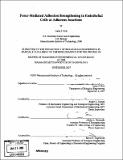Force-mediated adhesion strengthening in endothelial cells at adherens junctions
Author(s)
Kris, Anita S
DownloadFull printable version (3.319Mb)
Other Contributors
Massachusetts Institute of Technology. Biological Engineering Division.
Advisor
Roger D. Kamm.
Terms of use
Metadata
Show full item recordAbstract
Cells respond to the application of force with a variety of biochemical responses modulating their shape, structure, function, and proliferation. Two force-responsive links between the inside and outside of a cell are integrin proteins, which link a cell to the extracellular matrix (ECM), and cadherin proteins, which link neighboring cells to each other. The strength of integrin-ECM bonds has been noted to increase in response to the application of force. However, the strengthening of cadherin-cadherin bonds in response to force has not been studied. Here, we use magnetic trapping to probe adhesion strengthening at cadherin adherens junctions, using cadherin-coated magnetic beads to simulate neighboring cells and apply force at adherens junctions. 43% of beads exposed to a high force (2.1 nN) detached, compared to 31% of those exposed to a low-to-high force ramp followed by high force. This indicates that adherens junctions are strengthened by force application. The actin cytoskeleton and vasodilator-stimulated phosphoprotein (VASP) both associate with adherens junctions, so their role in adhesion strengthening at adherens junctions was also studied. Cells treated with actin-inhibitor cytochalasin D showed no difference in bead detachment from constant high force and from ramped followed by high force, indicating that the actin cytoskeleton is crucial in the adhesion strengthening response. Beads attached to cells expressing GFP-VASP, which behave like VASP-overexpressing cells, detached in 24% of trials when exposed to constant high force, compared to 39% of trials in response to ramped force. Cells expressing GFP-MITO-FPPPP, which behave like VASP-downregulated cells, showed no difference in bead detachment between application of high force and ramped force followed by high force. (cont.) These experiments indicate that VASP is necessary for the adhesion strengthening response, but high levels of VASP may slow actin restructuring and diminish the ability of the cytoskeletal linkages to respond to increasing force. The importance of VASP in cells' responses to forces from other cells suggest that modulation of VASP activity may play a role in tissue development, where cell-cell force responses are important, and the pathogenesis of certain diseases, where cell-cell adhesion is affected.
Description
Thesis (M. Eng.)--Massachusetts Institute of Technology, Biological Engineering Division, 2007. Includes bibliographical references (p. 57-60).
Date issued
2007Department
Massachusetts Institute of Technology. Department of Biological EngineeringPublisher
Massachusetts Institute of Technology
Keywords
Biological Engineering Division.